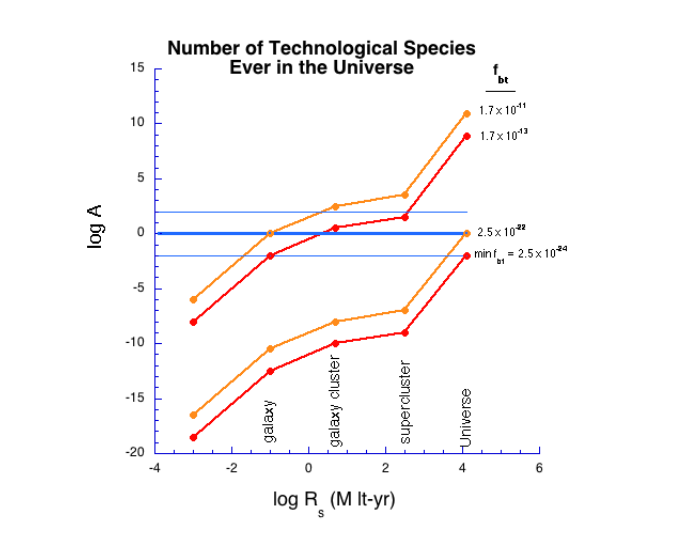Astrobiologists Revise the Chances of Finding Advanced ET Civilizations
The Drake equation describes “N”: the number of civilizations in our galaxy with which radio communication might be possible. Its author, the astronomer Frank Drake, originally penned it as a discussion point for one of the first meetings about the search for extraterrestrial intelligence in the early 1960s.

Since then, the equation has become one of the most famous in science. It consists of a set of terms that constrain the number of intelligent civilizations that might be contactable.
At that time, only a few of those terms were known with any real accuracy: the number of stars in the galaxy, for example. The other terms could only be guessed at—the fraction of stars with planets in the habitable zone, for example.
This has led to estimates for N that range over many orders of magnitude. At one end of the spectrum, optimists can calculate values for N in the hundreds of millions. But pessimists can always counter by calculating a value close to 0. Take your pick! That’s hardly a happy state of affairs for an emerging science.
Since then, more accurate values for other terms in the equation have emerged, first slowly and more recently at an increasingly rapid rate. The discovery of planets orbiting other stars has suddenly given astronomers a good idea of the fraction of stars with planets and the fraction with rocky planets in the habitable zone.
That raises an interesting question: how has all this new data influences the Drake equation? Today we get an answer of sorts thanks to the work of Adam Frank at the University of Rochester in New York and Woody Sullivan at the University of Washington in Seattle. “The empirical determination of exoplanet statistics has radically changed the nature and quality of constraints astrobiologists now have at their disposal when considering the prevalence of life in the Universe,” they say.
These guys use this new data, and a slightly different take on the equation itself, to find an important limit on how pessimistic it is possible to be about the existence of extraterrestrial civilizations.
Their method differs subtly from the traditional approach to the Drake equation. This focuses on the number of civilizations that are currently in existence. Instead, Frank and Sullivan calculate how many civilizations there have ever been. “We ask whether we are the only technological species that has ever arisen,” they say.
That immediately and significantly simplifies the Drake equation. When working out whether other civilizations currently exist, factors such as star formation rates and the length of time a technological civilization can exist, are hugely important. But they can be ignored entirely by considering only whether these civilizations have ever existed.
This allows Frank and Sullivan to reformulate the equation from being about the number of civilizations that exist now, to being about the probability of ours being the only one that has ever existed.
And by plugging in the new exoplanet statistics, Frank and Sullivan come up with a specific number. “We find that as long as the probability that a habitable zone planet develops a technological species is larger than about 10^-24, then humanity is not the only time technological intelligence has evolved,” they conclude.
That’s an interesting new angle on the Drake equation and the equally famous question “if they exist, where are they” otherwise known as the Fermi paradox. “With our approach we have, for the first time, provided a quantitative and empirically constrained limit on what it means to be pessimistic about the likelihood of another technological species ever having arisen in the history of the Universe,” say Frank and Sullivan.
And it immediately leads to an interesting conclusion. If the probability of a technological species arising on a given planet in a habitable zone is greater than one in 60 billion, then another technical species has probably arisen at some point elsewhere in the Milky Way. A tantalizing thought.
Ref: arxiv.org/abs/1510.08837 : A New Empirical Constraint on the Prevalence of Technological Species in the Universe
Keep Reading
Most Popular
Large language models can do jaw-dropping things. But nobody knows exactly why.
And that's a problem. Figuring it out is one of the biggest scientific puzzles of our time and a crucial step towards controlling more powerful future models.
The problem with plug-in hybrids? Their drivers.
Plug-in hybrids are often sold as a transition to EVs, but new data from Europe shows we’re still underestimating the emissions they produce.
Google DeepMind’s new generative model makes Super Mario–like games from scratch
Genie learns how to control games by watching hours and hours of video. It could help train next-gen robots too.
How scientists traced a mysterious covid case back to six toilets
When wastewater surveillance turns into a hunt for a single infected individual, the ethics get tricky.
Stay connected
Get the latest updates from
MIT Technology Review
Discover special offers, top stories, upcoming events, and more.